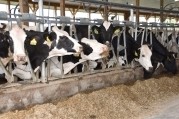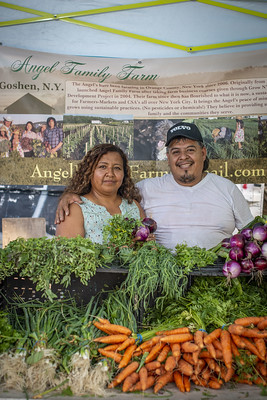|
Dec. 24
|
All offices closed for Christmas Day (observed)
|
|
Dec. 31
|
All offices closed for New Year's Day (observed)
|
|
Jan. 3
|
NAP Coverage Deadline for honey and maple sap
|
|
Jan. 3
|
Acreage Reporting Deadline for Maple Taps and Honeybees
|
|
Jan. 7
|
Organic and Transitional Education and Certification Program (OTECP) Deadline
|
|
Jan. 17
|
All offices closed for Martin Luther King Jr. Day
|
|
Jan. 18
|
Acreage Reporting Deadline for Apples, Grapes & Peaches
|
|
Feb. 1
|
NAP Coverage Deadline for beets, burdock, chicory, greens, herbs, leeks, lettuce, onions, radicchio, radishes, scallions, shallots, and turnips
|
|
Ongoing
|
Conservation Reserve Program (CRP) - Continuous Enrollment
|

USDA announced signup for the Dairy Margin Coverage (DMC) Program and expanded the program to allow dairy producers to better protect their operations by enrolling supplemental production. This signup period – which runs from Dec. 13, 2021 to Feb. 18, 2022 – enables producers to get coverage through this important safety-net program for another year as well as get additional assistance through the new Supplemental DMC.
Supplemental DMC will provide $580 million to better help small- and mid-sized dairy operations that have increased production over the years but were not able to enroll the additional production. Now, they will be able to retroactively receive payments for that supplemental production. Additionally, USDA’s Farm Service Agency (FSA) updated how feed costs are calculated, which will make the program more reflective of actual dairy producer expenses.
Supplemental DMC Enrollment
Eligible dairy operations with less than 5 million pounds of established production history may enroll supplemental pounds based upon a formula using 2019 actual milk marketings, which will result in additional payments. Producers will be required to provide FSA with their 2019 Milk Marketing Statement.
Supplemental DMC coverage is applicable to calendar years 2021, 2022 and 2023. Participating dairy operations with supplemental production may receive retroactive supplemental payments for 2021 in addition to payments based on their established production history.
Supplemental DMC will require a revision to a producer’s 2021 DMC contract and must occur before enrollment in DMC for the 2022 program year. Producers will be able to revise 2021 DMC contracts and then apply for 2022 DMC by contacting their local USDA Service Center.
DMC 2022 Enrollment
After making any revisions to 2021 DMC contracts for Supplemental DMC, producers can sign up for 2022 coverage. DMC provides eligible dairy producers with risk management coverage that pays producers when the difference between the price of milk and the cost of feed falls below a certain level. So far in 2021, DMC payments have triggered for January through October for more than $1.0 billion.
For DMC enrollment, producers must certify with FSA that the operation is commercially marketing milk, sign all required forms and pay the $100 administrative fee. The fee is waived for farmers who are considered limited resource, beginning, socially disadvantaged, or a military veteran. To determine the appropriate level of DMC coverage for a specific dairy operation, producers can use the online dairy decision tool.
Updates to Feed Costs
USDA is also changing the DMC feed cost formula to better reflect the actual cost dairy farmers pay for high-quality alfalfa hay. FSA will calculate payments using 100% premium alfalfa hay rather than 50%. The amended feed cost formula will make DMC payments more reflective of actual dairy producer expenses.
Additional Dairy Assistance
Today’s announcement is part of a broader package to help the dairy industry respond to the pandemic and other challenges. USDA is also amending Dairy Indemnity Payment Program (DIPP) regulations to add provisions for the indemnification of cows that are likely to be not marketable for longer durations, as a result, for example, of per- and polyfluoroalkyl substances. FSA also worked closely with USDA's Natural Resources Conservation Service to target assistance through the Environmental Quality Incentives Program ) and other conservation programs to help producers safely dispose of and address resource concerns created by affected cows. Other recent dairy announcements include $350 million through the Pandemic Market Volatility Assistance Program and $400 million for the Dairy Donation Program.
Additional details on these changes to DMC and DIPP can be found in a rule that will be published soon in the Federal Register. This rule also included information on the new Oriental Fruit Fly Program as well as changes to FSA conservation programs. A copy of the rule is available here.
|

USDA is rolling out a new insurance option specifically for agricultural producers with small farms who sell locally. The new Micro Farm policy simplifies record keeping and covers post-production costs like washing and value-added products.
USDA’s Risk Management Agency (RMA) created this new policy based on research directed by the 2018 Farm Bill, and it includes feedback from producers who grow for their local communities. The policy will be available beginning with the 2022 crop year.
The new policy is offered through Whole-Farm Revenue Protection (WFRP) and it has distinct provisions that can provide more access to the program, including:
- No expense or individual commodity reporting needed, simplifying the recordkeeping requirements for producers
- Revenue from post-production costs, such as washing and packaging commodities and value-added products, are considered allowable revenue
The Micro Farm policy is available to producers who have a farm operation that earns an average allowable revenue of $100,000 or less, or for carryover insureds, an average allowable revenue of $125,000 or less. RMA’s research showed that 85% of producers who sell locally reported they made less than $75,000 in gross sales.
The Micro Farm policy builds on other RMA efforts to better serve specialty and organic crop growers. This includes WFRP, which provides coverage for producers with larger operations that may not be eligible for Micro Farm. RMA recently made improvements to WFRP as part of a broader set of new policies and expanded policies to assist specialty crop and organic producers.
The Federal Crop Insurance Corporation approved the Micro Farm policy in late September, and additional details will be provided later this fall.
Crop insurance is sold and delivered solely through private crop insurance agents. A list of crop insurance agents is available at all USDA Service Centers and online at the RMA Agent Locator. Learn more about crop insurance and the modern farm safety net at rma.usda.gov.
|

Agricultural producers in New York who have not yet completed their crop acreage reports after planting should make an appointment with their Farm Service Agency (FSA) office before the applicable deadline.
An acreage report documents a crop grown on a farm or ranch and its intended uses. Filing an accurate and timely acreage report for all crops and land uses, including failed acreage and prevented planted acreage, can prevent the loss of benefits.
The following acreage reporting dates are applicable in New York:
January 3, 2022 - Maple Taps and Honeybees
January 18, 2022 - Apples, Grapes & Peaches
Service Center staff continue to work with agricultural producers via phone, email, and other digital tools. Because of the pandemic, some USDA Service Centers are open to limited visitors. Contact your Service Center to set up an in-person or phone appointment.
To file a crop acreage report, you will need to provide:
- Crop and crop type or variety
- Intended use of the crop.
- Number of acres of the crop.
- Map with approximate boundaries for the crop.
- Planting date(s).
- Planting pattern, when applicable.
- Producer shares.
- Irrigation practice(s).
- Acreage prevented from planting, when applicable.
- Other information as required.
Acreage Reporting Details
The following exceptions apply to acreage reporting dates:
- If the crop has not been planted by the acreage reporting date, then the acreage must be reported no later than 15 calendar days after planting is completed.
- If a producer acquires additional acreage after the acreage reporting date, then the acreage must be reported no later than 30 calendar days after purchase or acquiring the lease. Appropriate documentation must be provided to the county office.
Producers should also report crop acreage they intended to plant, but due to natural disaster, were unable to plant. Prevented planting acreage must be reported on form CCC-576, Notice of Loss, no later than 15 calendar days after the final planting date as established by FSA and USDA’s Risk Management Agency.
Noninsured Crop Disaster Assistance Program (NAP) policy holders should note that the acreage reporting date for NAP-covered crops is the earlier of the dates listed above or 15 calendar days before grazing or harvesting of the crop begins.
More Information
For questions, please contact your local FSA office. To locate your local FSA office visit farmers.gov/service-center-locator.
|

The U.S. Department of Agriculture (USDA) will provide pandemic assistance to cover certification and education expenses to agricultural producers who are certified organic or transitioning to organic. USDA will make $20 million available through the new Organic and Transitional Education and Certification Program (OTECP) as part of USDA’s broader Pandemic Assistance for Producers initiative, which provides new, broader and more equitable opportunities for farmers, ranchers and producers.
During the COVID-19 pandemic, certified organic and transitional operations faced challenges due to loss of markets, and increased costs and labor shortages, in addition to costs related to obtaining or renewing their organic certification, which producers and handlers of conventionally grown commodities do not incur. Transitional operations also faced the financial challenge of implementing practices required to obtain organic certification without being able to obtain the premium prices normally received for certified organic commodities.
Eligible Expenses
OTECP funding is provided through the Coronavirus Aid, Relief, and Economic Security Act (CARES Act). Certified operations and transitional operations may apply for OTECP for eligible expenses paid during the 2020, 2021 and 2022 fiscal years. For each year, OTECP covers 25% of a certified operation’s eligible certification expenses, up to $250 per certification category (crop, livestock, wild crop, handling and State Organic Program fee). This includes application fees, inspection fees, USDA organic certification costs, state organic program fees and more.
Crop and livestock operations transitioning to organic production may be eligible for 75% of a transitional operation’s eligible expenses, up to $750, for each year. This includes fees charged by a certifying agent or consultant for pre-certification inspections and development of an organic system plan.
For both certified operations and transitional operations, OTECP covers 75% of the registration fees, up to $200, per year, for educational events that include content related to organic production and handling in order to assist operations in increasing their knowledge of production and marketing practices that can improve their operations, increase resilience and expand available marketing opportunities. Additionally, both certified and transitional operations may be eligible for 75% of the expense of soil testing required under the National Organic Program (NOP) to document micronutrient deficiency, not to exceed $100 per year.
Applying for Assistance
Signup for 2020 and 2021 OTECP will be Nov. 8, 2021, through Jan. 7, 2022. Producers apply through their local Farm Service Agency (FSA) office and can also obtain one-on-one support with applications by calling 877-508-8364. Visit farmers.gov/otecp to learn more.
Additional Organic Support
OTECP builds upon USDA’s Organic Certification Cost Share Program (OCCSP) which provides cost share assistance of 50%, up to a maximum of $500 per scope, to producers and handlers of agricultural products who are obtaining or renewing their certification under the NOP.
Additionally, USDA’s Risk Management Agency announced improvements to the Whole-Farm Revenue Program including increasing expansion limits for organic producers to the higher of $500,000 or 35%. Previously, small and medium size organic operations were held to the same 35% limit to expansion as conventional practice producers. Also, producers can now report acreage as certified organic, or as acreage in transition to organic, when the producer has requested an organic certification by the acreage reporting date.
To learn more about USDA’s assistance for organic producers, visit usda.gov/organic.
|

The Farm Service Agency’s (FSA) Farm Storage Facility Loan (FSFL) program provides low-interest financing to help you build or upgrade storage facilities and to purchase portable (new or used) structures, equipment and storage and handling trucks.
Eligible commodities include corn, grain sorghum, rice, soybeans, oats, peanuts, wheat, barley, minor oilseeds harvested as whole grain, pulse crops (lentils, chickpeas and dry peas), hay, honey, renewable biomass, fruits, nuts and vegetables for cold storage facilities, floriculture, hops, maple sap & syrup, rye, milk, cheese, butter, yogurt, meat and poultry (unprocessed), eggs, and aquaculture (excluding systems that maintain live animals through uptake and discharge of water). Qualified facilities include grain bins, hay barns and cold storage facilities for eligible commodities.
Loans up to $50,000 can be secured by a promissory note/security agreement, loans between $50,000 and $100,000 may require additional security, and loans exceeding $100,000 require additional security.
You do not need to demonstrate the lack of commercial credit availability to apply. The loans are designed to assist a diverse range of farming operations, including small and mid-sized businesses, new farmers, operations supplying local food and farmers markets, non-traditional farm products, and underserved producers.
For more information, contact your local USDA Service Center or visit fsa.usda.gov/pricesupport.
|

Farmers can use USDA farm ownership microloans to buy and improve property. These microloans are especially helpful to beginning or underserved farmers, U.S. veterans looking for a career in farming, and those who have small and mid-sized farming operations.
Microloans have helped farmers and ranchers with operating costs, such as feed, fertilizer, tools, fencing, equipment, and living expenses since 2013.
Microloans can also help with farmland and building purchases and soil and water conservation improvements. FSA designed the expanded program to simplify the application process, expand eligibility requirements and expedite smaller real estate loans to help farmers strengthen their operations. Microloans provide up to $50,000 to qualified producers and can be issued to the applicant directly from the USDA Farm Service Agency (FSA).
To learn more about the FSA microloan program, contact your local USDA Service Center or visit fsa.usda.gov/microloans.
|

The Farm Service Agency (FSA) is accepting offers for specific conservation practices under the Conservation Reserve Program (CRP) Continuous Signup.
In exchange for a yearly rental payment, farmers enrolled in the program agree to remove environmentally sensitive land from agricultural production and to plant species that will improve environmental health and quality. The program’s long-term goal is to re-establish valuable land cover to improve water quality, prevent soil erosion, and reduce loss of wildlife habitat. Contracts for land enrolled in CRP are 10-15 years in length.
Under continuous CRP signup, environmentally sensitive land devoted to certain conservation practices can be enrolled in CRP at any time. Offers for continuous enrollment are not subject to competitive bidding during specific periods. Instead they are automatically accepted provided the land and producer meet certain eligibility requirements and the enrollment levels do not exceed the statutory cap.
For more information, including a list of acceptable practices, contact your local USDA Service Center or visit fsa.usda.gov/crp.
|
The USDA Farm Service Agency’s (FSA) Direct Farm Ownership loans are a resource to help farmers and ranchers become owner-operators of family farms, improve and expand current operations, increase agricultural productivity, and assist with land tenure to save farmland for future generations.
There are three types of Direct Farm Ownership Loans: regular, down payment and joint financing. FSA also offers a Direct Farm Ownership Microloan option for smaller financial needs up to $50,000.
Direct Farm Ownership Loans can be used to construct, purchase or improve farm dwellings, service buildings or other facilities, and to make improvements essential to an operation.
Applicants must provide FSA with an estimate of the total cost of all planned development that completely describe the work, prior to loan approval and must show proof of sufficient funds to pay for the total cost of all planned development at or before loan closing. In some instances, applicants may be asked to provide certified plans, specifications or contract documents. The applicant cannot incur any debts for materials or labor or make any expenditures for development purposes prior to loan closing with the expectation of being reimbursed from FSA funds.
Construction and development work may be performed either by the contract method or the borrower method. Under the contract method, construction and development contractors perform work according to a written contract with the applicant or borrower. If applying for a direct loan to finance a construction project, the applicant must obtain a surety bond that guarantees both payment and performance in the amount of the construction contract from a construction contractor.
A surety bond is required when a contract exceeds $100,000. An authorized agency official determines that a surety bond appears advisable to protect the borrower against default of the contractor or a contract provides for partial payments in excess of the amount of 60 percent of the value of the work in place.
Under the borrower method, the applicant or borrower will perform the construction and development work. The borrower method may only be used when the authorized agency official determines, based on information from the applicant, that the applicant possesses or arranges to obtain the necessary skill and managerial ability to complete the work satisfactorily and that such work will not interfere with the applicant’s farming operation or work schedule.
Potential applicants should visit with FSA early in the initial project planning process to ensure environmental compliance.
For more eligibility requirements and information about FSA Loan programs, contact your local USDA Service Center or visit fsa.usda.gov.

The U.S. Department of Agriculture will begin issuing final pandemic assistance payments to timber harvesters and timber hauling businesses through the Pandemic Assistance for Timber Harvesters and Haulers (PATHH) program starting next week. In total, $200 million will be provided to loggers and log trucking businesses who experienced a gross revenue loss of at least 10% during the period of Jan. 1 through Dec. 1, 2020, compared to the period of Jan. 1 through Dec. 1, 2019. This support is part of USDA’s broader Pandemic Assistance for Producers initiative.
Eligible PATHH applicants must have derived at least 50 percent of total gross revenue from timber harvesting and/or timber hauling. Specifically, eligible activities included cutting timber, transporting timber and/or the processing of wood on-site on the forest land, such as chipping, grinding, converting to biochar or cutting to smaller lengths.
The Consolidated Appropriations Act, 2021, authorized up to $200 million for PATHH. FSA issued initial payments up to $2,000 as applications were approved. Now that signup has ended and FSA has evaluated remaining funds, FSA has started to issue second payments to those applicants whose calculated payment amount was over $2,000.
Based on the number of actual PATHH applications filed, FSA will be required to lower the payment limitation for PATHH from $125,000 to $75,000 and apply a payment factor of 70.5% across all calculated payments to ensure program outlays do not exceed the available funding. These provisions were previously outlined in the Notice of Funding Availability in the event the revenue loss reported exceeded available funding.
|
New York State Department of Agriculture and Markets Hosting Webinar for Interested Businesses December 13, Join the Webinar Here
New York State Agriculture Commissioner Richard A. Ball encouraged New York State’s agricultural industry to apply for the $800 million COVID-19 Pandemic Small Business Recovery Grant Program. Grants are available for eligible small businesses that have revenues up to $2.5 million and are experiencing hardship due to COVID-19. Additional information and the application are available here.
Commissioner Ball said, “There are so many agribusinesses that are still feeling the effects of the COVID-19 pandemic and facing many challenges after having lost markets at schools and restaurants. This grant program provides an opportunity for our food and beverage producers, our farmers, and our growers to access some much-needed capital to help recover their losses and rebuild their businesses.”
Empire State Development and Lendistry, the minority-led Community Development Financial Institution that was selected to administer the program, are accepting and reviewing applications on a rolling basis. There is no deadline at this time. Questions about the program can be directed to Lendistry at (877) 721-0097.
Empire State Development Acting Commissioner and President & CEO-designate Hope Knight said, “New York’s food and agricultural industry is vital to the state’s economic recovery and ensuring that our agribusinesses are moving forward and thriving is crucial for the state’s economic post-pandemic progress. We encourage eligible agribusinesses to apply for these grants, which will help us all move forward.”
Grants for a minimum award of $5,000 and a maximum award of $50,000 are calculated based on a New York State business' annual gross receipts for 2019. Reimbursable COVID-19 related expenses must have been incurred between March 1, 2020 and April 1, 2021 and can include payroll costs; commercial rent or mortgage payments for New York State-based property; payment of local property or school taxes; insurance and utility costs; costs of personal protection equipment necessary to protect worker and consumer health and safety; costs for heating, ventilation, and air conditioning, or other machinery and equipment; and supplies and materials necessary for compliance with COVID-19 health and safety protocols.
Additionally, the limitation for businesses that received Federal Paycheck Protection Program loans has been increased from $100,000 to $250,000.
COVID-19 Pandemic Small Business Recovery Grant Program Webinar
To help the agricultural industry apply for the COVID-19 Pandemic Small Business Recovery Grant Program, the Department is hosting a webinar for interested businesses on December 13, 2021 at 11 a.m. The webinar will provide an overview of the grant program, the level of funding available, and how to apply for funds. To access the webinar, please visit this link.
For additional information regarding the various resources available to support businesses seeking pandemic relief, ESD has created a webpage, https://esd.ny.gov/business-pandemic-recovery-initiative. The webpage is continuously updated as more details and funding information becomes available.
|